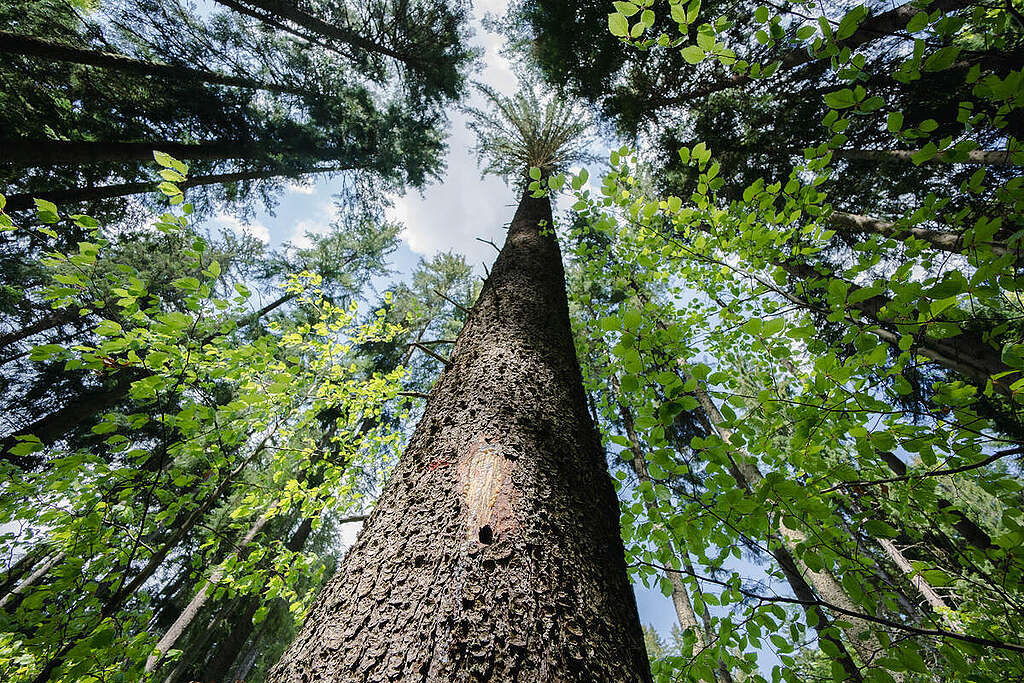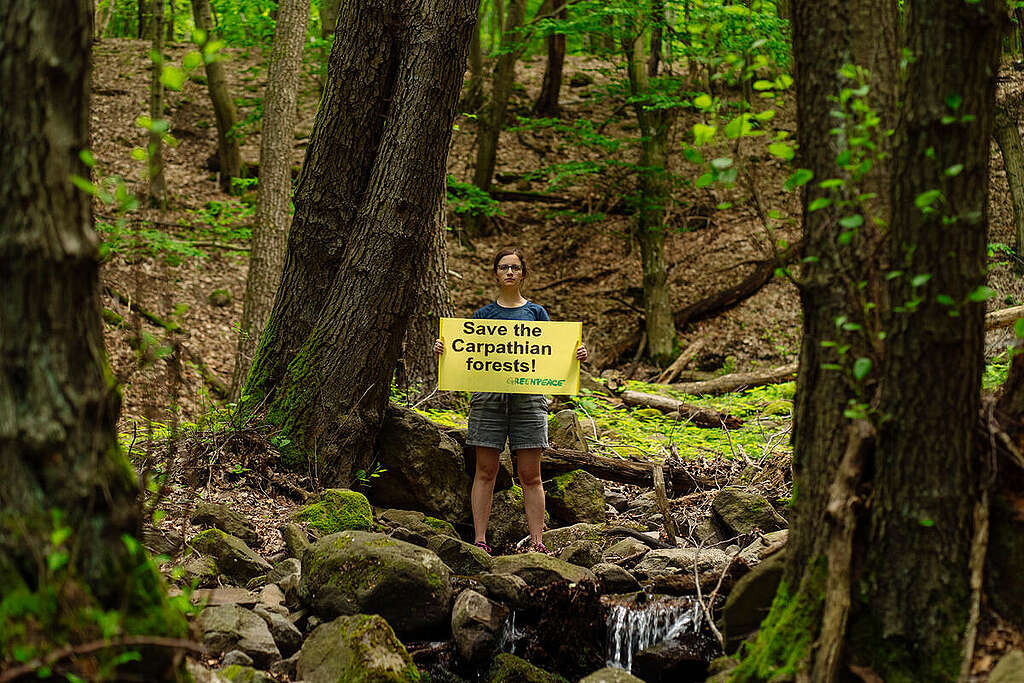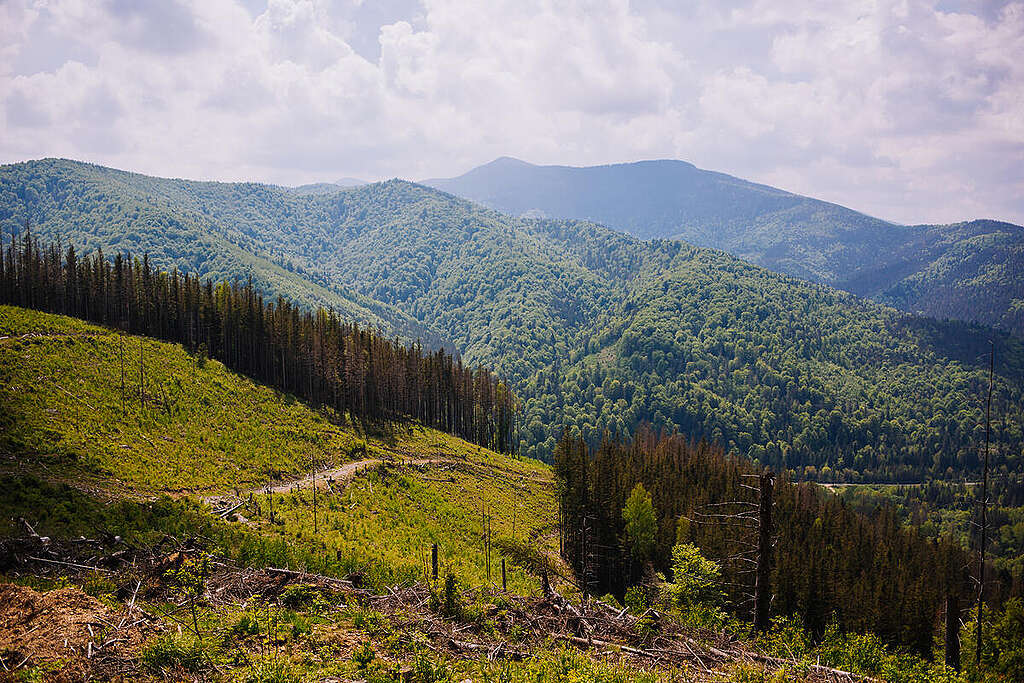Imagine a 40 day expedition through the forest just exploring. You’d look forward to seeing the surrounding tall trees, leaves dancing and swaying to the gentle breeze, the smell of the forest and crunch of leaves as they give way to exploration deeper into the forestside while spotting an animal here and there, marvelling at the rich biodiversity found in natural forests. Well, this was not the case for a team of Greenpeace Central & Eastern Europe volunteers, staff and activists who embarked on a 40 day adventurous journey over five countries through the Carpathian mountains.
 Expedition’s Day 10 in Bucovina, Romania. Mobile Rescue Station met a local reputed activist called Tibi, who dedicated his life to exposing illegal logging and who keeps signalling a lot of cases of illegal transport, some of which are captured by the supervising camera installed in front of his house. © Răzvan Dima / Greenpeace
Expedition’s Day 10 in Bucovina, Romania. Mobile Rescue Station met a local reputed activist called Tibi, who dedicated his life to exposing illegal logging and who keeps signalling a lot of cases of illegal transport, some of which are captured by the supervising camera installed in front of his house. © Răzvan Dima / GreenpeaceThe Carpathian mountain range is rich in ecological value and spans through Central Europe. The expedition team dubbed Mobile Rescue Station (MRS) had stops in Romania, Ukraine, Hungary, Poland and Slovakia with one mission in mind; to bring the story of the lack of protection of old growth forests in the Carpathian region to the limelight.
Expectation Vs Reality
In the Hungarian Mátras, the Carpathian Expedition team hiked through a wild gorge valley boasting a stream and huge beech trees reaching to the sky. The Mátras, part of the North Hungarian Mountains and the Carpathians are rich in springs and streams (360 springs are known), while in several places, naturally carbonated mineral water and medicinal water spring up in the forest and on the outskirts of the nearby settlements. These natural mineral waters, locally known as ‘csevice’, flow up from volcanic rocks at great depths. The springs and streams provide home and breeding grounds for many amphibians and reptiles.
 Greenpeace activist visits the Mátras in Hungary to raise awareness of the beauty and destruction in the Carpathian forests. © Max Zielinski / Greenpeace
Greenpeace activist visits the Mátras in Hungary to raise awareness of the beauty and destruction in the Carpathian forests. © Max Zielinski / GreenpeaceHowever in the Mátra mountain range, the expeditioners were confronted with cleared hillsides in a national park and Natura 2000 area. 45% of Hungary’s forests are protected in theory, but in reality only 5.6% of them are managed by national parks for nature conservation. In all other forests – 90% of Hungarian forests – timber production is the primary objective. After speaking to forest rangers and forest ecologists, they learnt that in Hungary, out of 2 million hectares of woodlands, only 300 hectares are natural forests (less than 0.02%).
What will be left of the Carpathians?
“When I was packing my stuff for the Carpathians expedition, one of my friends asked me: “Do you really think that it is possible to win the battle for the Carpathians?” And, to be honest, I said that I didn’t know. But after the expedition, I am pretty sure that it is possible – we do, however, need to work on it now.
During those days with the Mobile Rescue Station (MRS) we saw unbelievably beautiful mountains and hundreds of kilometres of logging. We saw old forests that should be under protection and tree stumps within a few metres of these. We saw pure nature with its inhabitants (even a young owl we were lucky to meet) and how the logging changed this natural environment right before our eyes.”
 During their Carpathian expedition, Greenpeace team of Ukrainian, Polish and Romanian activists visited both the logging site providing wood to Swiss Krono and one of Swiss Krono’s processing sites in Broshniv-Osada. © Dominik Werner / Greenpeace
During their Carpathian expedition, Greenpeace team of Ukrainian, Polish and Romanian activists visited both the logging site providing wood to Swiss Krono and one of Swiss Krono’s processing sites in Broshniv-Osada. © Dominik Werner / Greenpeace“I wanted to see with my own eyes how nature had been devastated by those who were supposed to protect it. With the Carpathian Emergency Initiative, we explored the “invisible” Turnicki National Park. It’s called “invisible” because it lacks proper protection, despite hosting untouched areas for centuries. The Carpathians are not just about beautiful nature. We regularly saw cut-down trees, roads turned into swamps by trucks, and rows of dying pines planted to replace old forests, which cannot be regenerated this way.” Agata Czarnocka, forest activist from Poland.
“The most significant part of this deforested site for me was not the huge stumps left behind, which were of course awful, but the graveyard of downed trees at the edge of the remaining forest. We need to return to ancestral views of wood as a valuable and renewable craft/building material that takes artisan work and care, as opposed to modern views of wood as simply a cheap export. Humans continue to log and exploit our planet for short-term gain without considering the lasting increasing damage that endures decades after we’ve had our fill.” Bethany, Volunteer with Greenpeace CEE.
Extreme weather – Heatwaves, fires, drought, and floods are at an all-time peak as Earth faces an unprecedented crisis in global heating and biodiversity loss. Each year, we witness the loss of precious forests, savannahs, wet- and grasslands, lakes, and rivers, due to industrial agriculture, deforestation and unchecked economic growth and greed. Our fear and hopelessness can turn into collective action for the planet and biodiversity. We can’t let world leaders make empty promises that lead to a road to nowhere. The Carpathians are dying, and they need our help right now. Save the carpathians!
Save the Carpathians by adding your name to this petition. Read the Carpathians Report report.
Kateryna Bystrytska, Communication officer for Greening Ukraine Reconstruction Project, Greenpeace CEE.

 1 year ago
156
1 year ago
156

